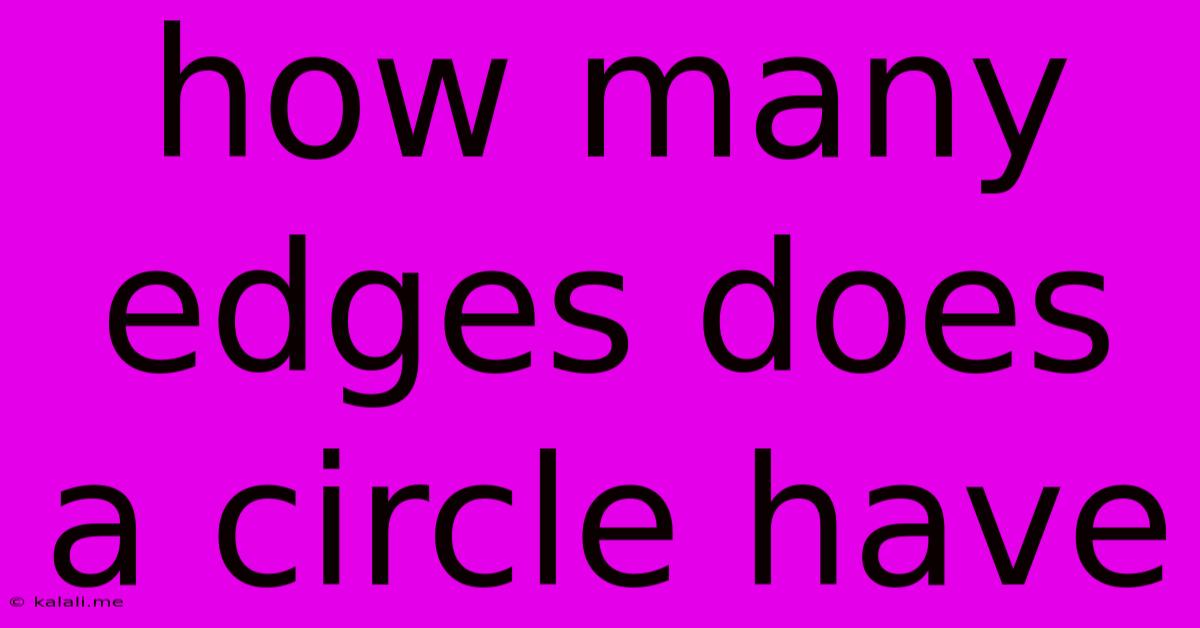How Many Edges Does A Circle Have
Kalali
May 09, 2025 · 3 min read

Table of Contents
How Many Edges Does a Circle Have? A Surprisingly Complex Question
This seemingly simple question – how many edges does a circle have? – is more nuanced than you might initially think. The answer depends heavily on how you define "edge" and the mathematical context. This article will explore different perspectives, clarifying the ambiguity and providing a comprehensive understanding. Understanding this concept is crucial for anyone delving into geometry, topology, and even computer graphics.
A circle, in its simplest definition, is the set of all points in a plane that are equidistant from a given point, the center. This definition doesn't inherently mention edges. This leads to the core of the problem: the very notion of an "edge" is context-dependent.
The Euclidean Perspective: No Edges
From a purely Euclidean geometry perspective, a circle has zero edges. An edge implies a boundary where the shape abruptly ends or changes its properties. A circle is a continuous curve; it smoothly transitions from one point to the next without any sharp breaks or discontinuities. There's no defined line or segment that can be explicitly called an "edge." Think of drawing a circle with a pencil – your pencil traces a continuous path, not a series of connected segments.
The Topological Perspective: One Edge (or Zero)
Topology, a branch of mathematics dealing with properties that are preserved under continuous deformations, offers a different viewpoint. Topologically, a circle can be considered a one-dimensional manifold with a single, continuous boundary. In this context, you could argue it has one edge representing the entire circumference. However, this depends on the specific topological definition used; some definitions might still consider it to have no edges. This divergence highlights the importance of defining your terms precisely within a specific mathematical framework.
Practical Applications and Discretization
In real-world applications and computer graphics, circles are often represented as approximations. For instance, a circle in a computer game might be rendered as a polygon with a large number of sides. In this case, the number of "edges" would simply be the number of sides of the approximating polygon. This is a form of discretization, where a continuous curve is represented by a finite set of discrete points and lines. The higher the number of sides, the better the approximation to a true circle. Therefore, the number of "edges" becomes arbitrary depending on the level of detail required.
Beyond the Basics: Related Concepts
Understanding this ambiguity helps clarify related concepts:
- Circumference: This refers to the distance around the circle, not the number of edges.
- Diameter: The distance across the circle through the center.
- Radius: The distance from the center to any point on the circle.
These terms are well-defined regardless of the interpretation of "edges."
Conclusion: Context is Key
Ultimately, the question of how many edges a circle has depends entirely on the context. In Euclidean geometry, the answer is definitively zero. However, topological considerations might lead to an answer of one. Practical applications, particularly in computer graphics and simulations, might involve a large (but still finite) number of edges depending on the approximation used. Understanding the different perspectives is crucial for a thorough understanding of geometrical concepts and their applications. The seemingly simple question of a circle's edges opens up a fascinating exploration of mathematical nuances and their real-world implications.
Latest Posts
Latest Posts
-
How Much Is 10 Quarters In Dollars
Jul 06, 2025
-
How Do You Beat Stage 9 On Bloxorz
Jul 06, 2025
-
What Is 1 2 Equivalent To In Fractions
Jul 06, 2025
-
How Do You Say Pork In Spanish
Jul 06, 2025
Related Post
Thank you for visiting our website which covers about How Many Edges Does A Circle Have . We hope the information provided has been useful to you. Feel free to contact us if you have any questions or need further assistance. See you next time and don't miss to bookmark.